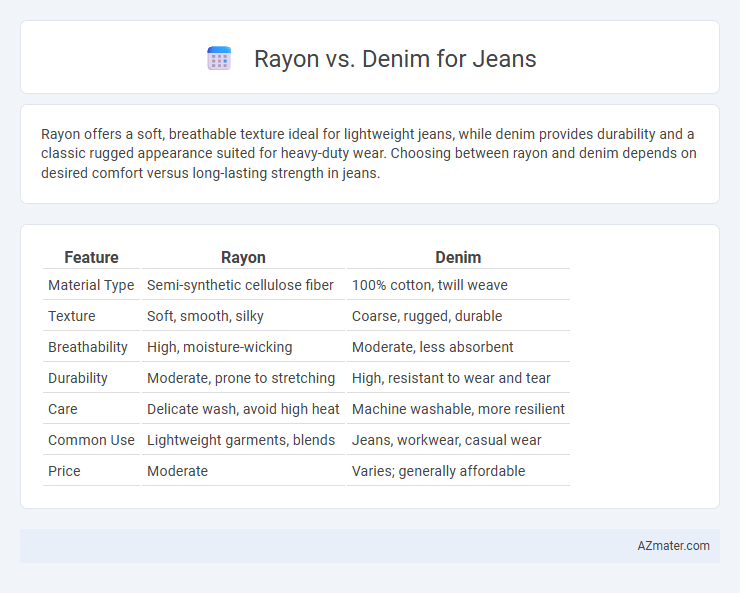Rayon offers a soft, breathable texture ideal for lightweight jeans, while denim provides durability and a classic rugged appearance suited for heavy-duty wear. Choosing between rayon and denim depends on desired comfort versus long-lasting strength in jeans.
Table of Comparison
| Feature | Rayon | Denim |
|---|---|---|
| Material Type | Semi-synthetic cellulose fiber | 100% cotton, twill weave |
| Texture | Soft, smooth, silky | Coarse, rugged, durable |
| Breathability | High, moisture-wicking | Moderate, less absorbent |
| Durability | Moderate, prone to stretching | High, resistant to wear and tear |
| Care | Delicate wash, avoid high heat | Machine washable, more resilient |
| Common Use | Lightweight garments, blends | Jeans, workwear, casual wear |
| Price | Moderate | Varies; generally affordable |
Introduction to Rayon and Denim Fabrics
Rayon is a semi-synthetic fabric made from regenerated cellulose fibers, offering softness, breathability, and a smooth texture ideal for comfortable, lightweight clothing. Denim, traditionally composed of durable cotton twill weave, provides strength, longevity, and a rugged aesthetic, making it the preferred choice for classic jeans. Understanding the fundamental differences between rayon's silky feel and denim's robust structure is essential for consumers seeking specific fabric qualities for their denim apparel.
Origins and Manufacturing Processes
Rayon, a semi-synthetic fiber made from cellulose, originates from wood pulp through a chemical process involving carbon disulfide and sodium hydroxide, offering a smooth and breathable fabric ideal for lightweight jeans. Denim, traditionally woven from 100% cotton, derives from the French town of Nimes and is characterized by a sturdy twill weave that creates a durable texture, achieved through indigo dyeing and rigorous washing treatments. The manufacturing of rayon jeans involves fiber regeneration and spinning, while denim jeans undergo yarn dyeing, weaving, and repeated washing to enhance softness and fade patterns.
Texture and Appearance Comparison
Rayon offers a smooth, silky texture with a lightweight feel, making it comfortable and breathable for jeans, while denim is characterized by its coarse, durable twill weave that provides a rugged, structured appearance. Rayon jeans typically exhibit a slight sheen and a fluid drape, contrasting denim's matte finish and stiff form that develop natural creases over time. The distinct textures influence the overall look and feel, with rayon delivering a soft, polished aesthetic and denim offering a classic, sturdy style favored in casual wear.
Comfort and Wearability
Rayon offers superior breathability and softness, making jeans comfortable for extended wear, especially in warmer climates. Denim, composed primarily of cotton with a twill weave, provides durability and structure but can be less flexible and softer compared to rayon-blended fabrics. Jeans made with a blend of rayon and denim balance comfort and wearability, combining the softness of rayon with denim's toughness.
Durability and Longevity
Rayon jeans offer a softer feel but lack the durability of denim, which is woven from cotton twill known for its sturdy structure and resistance to wear. Denim's robust fibers and tight weave ensure longer longevity and better resistance to tearing, making it ideal for everyday wear and heavy use. Jeans crafted from denim maintain their shape and strength through multiple washes, whereas rayon fabrics tend to weaken and show signs of wear more quickly.
Maintenance and Care Requirements
Rayon jeans require delicate care due to the fabric's sensitivity to moisture and heat, calling for gentle hand washing or cold machine cycles and air drying to prevent shrinking and weakening of fibers. Denim, composed primarily of cotton, offers more durability and can withstand regular machine washing, but to maintain color and fabric strength, it is best washed inside out with cold water and minimal detergent. Both fabrics benefit from avoiding high heat drying, though denim is generally more forgiving in maintenance compared to the high-maintenance, moisture-sensitive rayon.
Breathability and Weather Suitability
Rayon offers superior breathability compared to denim, making it ideal for warm and humid weather due to its moisture-wicking properties and lightweight texture. Denim, made from thicker cotton fabric, provides better insulation and durability, which suits cooler climates and offers resistance against wind and minor abrasions. Choosing between rayon and denim for jeans depends largely on the need for airflow versus weather protection, influencing comfort in varying environmental conditions.
Eco-Friendliness and Sustainability
Rayon and denim differ significantly in eco-friendliness and sustainability; rayon, often derived from wood pulp, has a higher environmental impact due to chemical processing and deforestation risks, whereas denim, typically made from cotton, presents challenges with water-intensive cultivation but benefits from recycling and organic options. Sustainable denim manufacturers are adopting organic cotton, water-saving techniques, and recycled fibers to reduce environmental footprints, while sustainable rayon alternatives like lyocell offer more eco-friendly production methods with closed-loop systems minimizing toxic waste. Consumers prioritizing eco-conscious jeans should consider certified organic denim or responsibly sourced lyocell fibers to balance style with environmental responsibility.
Popular Uses in Jeans and Fashion Trends
Rayon is often used in jeans to enhance softness, breathability, and drape, making it popular for lightweight, comfortable denim blends favored in summer collections and casual wear. Denim, made primarily from cotton with a sturdy twill weave, remains the quintessential fabric for durable, classic jeans that define timeless fashion trends and streetwear culture. Recent fashion trends incorporate rayon to create stretch denim blends that offer both comfort and style, appealing to consumers seeking versatility and modern aesthetics in their wardrobe.
Choosing the Right Fabric: Key Considerations
Rayon offers a soft, breathable texture ideal for lightweight, comfortable jeans, while denim provides durability and classic ruggedness suited for everyday wear. Consider factors such as fabric weight, stretch, and moisture absorption when selecting between rayon and denim to match your lifestyle and climate conditions. Prioritizing fabric performance alongside appearance ensures jeans that maintain both style and comfort over time.

Infographic: Rayon vs Denim for Jean
 azmater.com
azmater.com